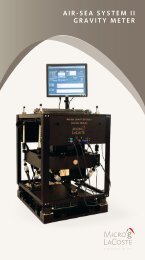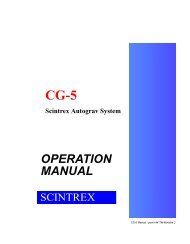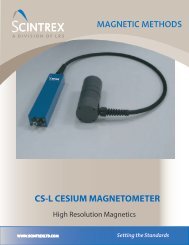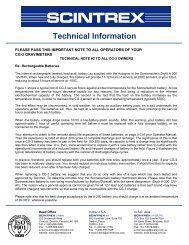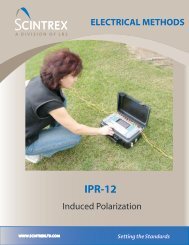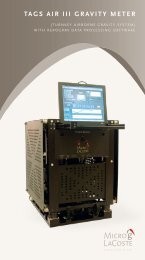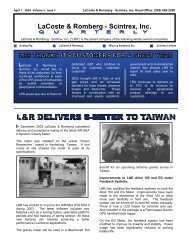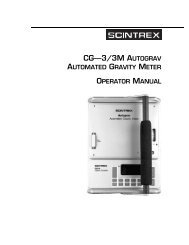Cs-3 Manual - Scintrex
Cs-3 Manual - Scintrex
Cs-3 Manual - Scintrex
Create successful ePaper yourself
Turn your PDF publications into a flip-book with our unique Google optimized e-Paper software.
The warm-up is over in few minutes after a cold start. However, if theoperating temperature is already established, it takes only few millisecondsfor the magnetometer to start oscillating after a turn on or after an orientationchange from a dead zone into the active zone.In contrast, a locked oscillator magnetometer invariably contains a voltagecontrolled oscillator (VCO), whose frequency in normal operation is forced(locked) by the control electronics to follow the resonant Larmor frequency.However, at every start-up, cold or warm, before the locking is acquired, theVCO frequency has to be swept relatively slowly until it comes close enoughto the Larmor frequency. Then the locking takes place and the magnetometerbecomes operational.Note that the Larmor frequency is known beforehand only coarsely andconsequently this search process takes several seconds. The same searchprocedure takes place if the lock is lost because of a fast field change or adisturbing AC magnetic field.Fast Response and TrackingThe response of a self-oscillating magnetometer to the magnetic fieldchanges is extremely fast. It has been experimentally determined that theLarmor frequency precisely changed in response to the step changes ofseveral thousand nT within a Larmor period. Equally, the magnetometerfollowed sinusoidal field changes of the amplitude of hundreds nT at the rateof several kHz without appreciable lag in response.In contrast, the rate of ambient field change, which a locked oscillatormagnetometer could follow without losing lock, is much smaller. In addition,spurious fields, either AC (50-400Hz) or pulsed, in the range of severalhundred nT cause the magnetometer to lose lock.Low Susceptibility to Electromagnetic FieldsThe susceptibility to spurious EM fields depends very much on the principleof operation. Most widely encountered spurious fields originate from thepower lines and the airborne geophysical EM systems, and are in thefrequency range of 50Hz to several thousand Hz. In general, thesusceptibility increases greatly as the frequency of the interfering fieldapproaches the operating (Larmor, proton precession) frequency.Proton precession magnetometers (including Overhauser) have lowsusceptibility for two reasons:• they use induction coils to detected proton precessionivCS-3 <strong>Manual</strong> - part # 762701 Revision 1.0



